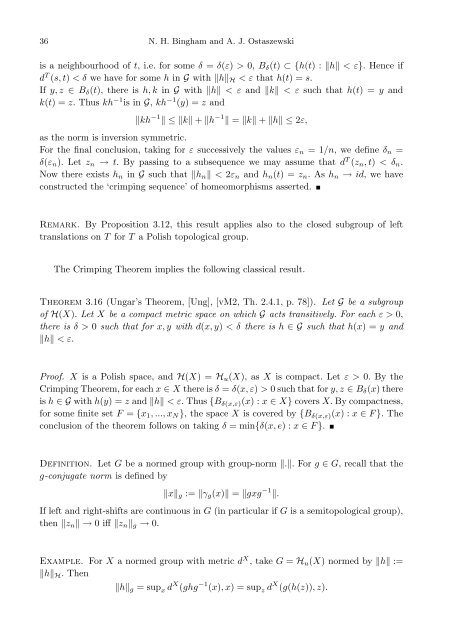Normed versus topological groups: Dichotomy and duality
Normed versus topological groups: Dichotomy and duality
Normed versus topological groups: Dichotomy and duality
You also want an ePaper? Increase the reach of your titles
YUMPU automatically turns print PDFs into web optimized ePapers that Google loves.
36 N. H. Bingham <strong>and</strong> A. J. Ostaszewskiis a neighbourhood of t, i.e. for some δ = δ(ε) > 0, B δ (t) ⊂ {h(t) : ‖h‖ < ε}. Hence ifd T (s, t) < δ we have for some h in G with ‖h‖ H < ε that h(t) = s.If y, z ∈ B δ (t), there is h, k in G with ‖h‖ < ε <strong>and</strong> ‖k‖ < ε such that h(t) = y <strong>and</strong>k(t) = z. Thus kh −1 is in G, kh −1 (y) = z <strong>and</strong>‖kh −1 ‖ ≤ ‖k‖ + ‖h −1 ‖ = ‖k‖ + ‖h‖ ≤ 2ε,as the norm is inversion symmetric.For the final conclusion, taking for ε successively the values ε n = 1/n, we define δ n =δ(ε n ). Let z n → t. By passing to a subsequence we may assume that d T (z n , t) < δ n .Now there exists h n in G such that ‖h n ‖ < 2ε n <strong>and</strong> h n (t) = z n . As h n → id, we haveconstructed the ‘crimping sequence’ of homeomorphisms asserted.Remark. By Proposition 3.12, this result applies also to the closed subgroup of lefttranslations on T for T a Polish <strong>topological</strong> group.The Crimping Theorem implies the following classical result.Theorem 3.16 (Ungar’s Theorem, [Ung], [vM2, Th. 2.4.1, p. 78]). Let G be a subgroupof H(X). Let X be a compact metric space on which G acts transitively. For each ε > 0,there is δ > 0 such that for x, y with d(x, y) < δ there is h ∈ G such that h(x) = y <strong>and</strong>‖h‖ < ε.Proof. X is a Polish space, <strong>and</strong> H(X) = H u (X), as X is compact. Let ε > 0. By theCrimping Theorem, for each x ∈ X there is δ = δ(x, ε) > 0 such that for y, z ∈ B δ (x) thereis h ∈ G with h(y) = z <strong>and</strong> ‖h‖ < ε. Thus {B δ(x,ε) (x) : x ∈ X} covers X. By compactness,for some finite set F = {x 1 , ..., x N }, the space X is covered by {B δ(x,ε) (x) : x ∈ F }. Theconclusion of the theorem follows on taking δ = min{δ(x, e) : x ∈ F }.Definition. Let G be a normed group with group-norm ‖.‖. For g ∈ G, recall that theg-conjugate norm is defined by‖x‖ g := ‖γ g (x)‖ = ‖gxg −1 ‖.If left <strong>and</strong> right-shifts are continuous in G (in particular if G is a semi<strong>topological</strong> group),then ‖z n ‖ → 0 iff ‖z n ‖ g → 0.Example. For X a normed group with metric d X , take G = H u (X) normed by ‖h‖ :=‖h‖ H . Then‖h‖ g = sup x d X (ghg −1 (x), x) = sup z d X (g(h(z)), z).
















